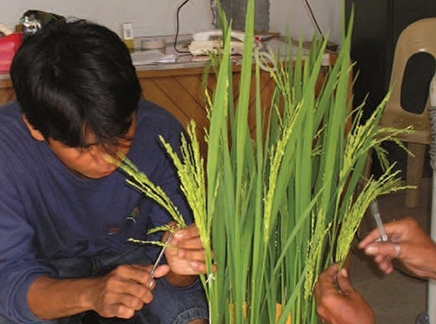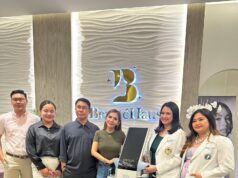(Cross-pollination is performed by removing the anthers of the female parent to prevent self-pollination and using pollen from the male parent to pollinated the emasculated florets. The result are “naked” F1 seeds from which potentially superior varieties can be derived. Cross-pollination is performed by removing the anthers of the female parent to prevent self-pollination and using pollen from the male parent to pollinated the emasculated florets. The result are “naked” F1 seeds from which potentially superior varieties can be derived. IRRI Photo)
(Last of Two Parts)
SCIENCE CITY OF MUÑOZ – “It was just the first step in rice breeding,” Alfonso emphasized.
The succeeding steps require a “breeder’s eye” as the seed produced from this early stage, referred to as F1 hybrids or first filial generation, and later the seeds produced by planting it in small plots, which is called F2 or second filial generation seeds, results in having plants that are very tall, very short or having intermediate height, and appearing to be vulnerable to certain pest’s attacks.
“The suspected bad plants are discarded while the promising ones are selected to be advanced to the next generation growing,” Alfonso said. “Larger plots are used for planting to widen the opportunities in finding the plants that exhibit the ‘traits of interest’.”
It is a numbers game, really, he said. “You select the best ones and discard that seem not very promising.”
“Breeders make many cross combinations and they plant a big number of individual plants to increase the chance of determining the excellent plants,” Alfonso said.
F3 plants are grown in a similar fashion but with a smaller population.
A few promising plants that are likely to exhibit the traits being combined together by the breeder are selected for advancement to F4. This cycle is repeated until F8. By then, the number of selections per cross combination is dramatically reduced to a few “elite lines”, which are already considered “uniform”.
The plant breeder said that advancement of materials from F1 to F8 again requires a field area for growing the plants, a work area for cleaning and storing seeds, and facilities for testing the lines being advanced.
“Test facilities can be simple and inexpensive but should be effective,” Alfonso said. “For disease screening, for example, what is needed is a facility to grow the bacteria or fungi that cause the diseases, inoculate them into the plants, and observe the plants for their reaction.”
Screening of the grain’s quality means observing the grains, taking measurements, de-hulling them, and cooking them to test their eating quality. Testing the lines while advancing them to the next generation helps ensure the presence of the desired traits in the lines being advanced, he said.
The breeder, Alfonso said, is rigid in the selection process. He doesn’t hesitate to discard suspicious cross combinations even if they are already in the advanced generation. He knows that if he keeps them for further testing, they may prove to be inefficient and therefore it would just be a wasteful exercise.
The few selected elite lines from each cross combination are grown in advanced observational nursery to verify whether they possess the traits of interest. Basic traits, like its maturity, resistance to insect’s attack, disease resistance, grain quality, and so on, are observed. Those that don’t meet the standards are discarded, he said.
Yield trials
After undergoing the various processes involved in the step by step stages of development, comes the “testing” which is the preliminary yield trial (PYT). This is done systematically to have a good prediction of yield when planted in bigger areas.
Replications and statistical tools are used to identify the highest yielding lines that meet the other requirements.
“Then the best selections from PYT are entered into the National Cooperative Test to determine their performance in different parts of the country,” Alfonso said. “If they met the requirements and if they performed better than the designated standard or ‘check’ variety, they are recommended by the Rice Technical Working Group of the National Seed Industry Council (NSIC) for release as a new variety.
Alfonso emphasized that these stages are only for “conventional breeding to produce an inbred variety”. The inbred variety, he said, can be planted repeatedly and their characteristics do not change much season after season.
It is very much different from the hybrid rice variety, he underscored. The hybrid variety, he added, has two genetically different parents that typically display heterosis or hybrid vigor. Although known to produce up to 30 percent more rice than the best-yielding inbred rice varieties, it can’t be used for the subsequent generations of planting.
Newer needs for breeding
Alfonso said that although the basic steps in rice breeding remain the same, there is a felt need to shorten its development.
This requires some special facilities, equipment and trained personnel, he said.
Tissue culture using anthers of the F1 or F2 plants, he said, can be perfected to immediately produce uniform or stable lines that can be readily tested in the advanced observational nursery. This means, he added, saving about three years in the process of breeding new rice varieties.
“Even the testing for specific pest reaction or eating quality parameters can be made more efficient by using equipment and protocols that allow the evaluation of a large number of populations while generating highly accurate results,” Alfonso said.
Lastly, modern biotechnological tools, such as genetic engineering, can bypass the sexual process (cross-pollination) and makes it possible to transfer traits from other organisms, he said.





